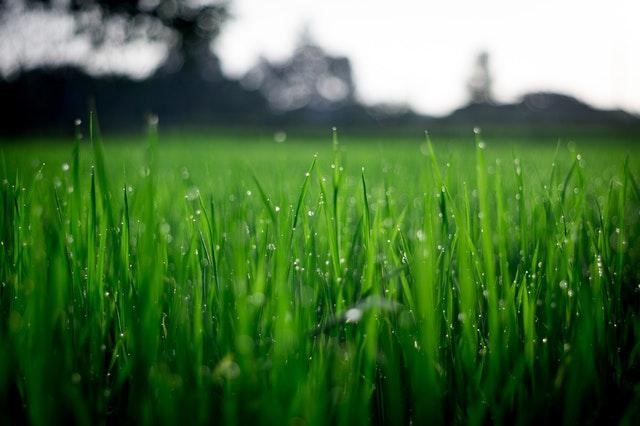A beautiful lawn does not appear in your yard just by chance. Keeping your lawn healthy and green requires a lot of attention.
Fortunately, anybody who wants to learn how to manage their backyard can discover the secrets to beautiful, lush grass. The best way is to use a lawn care service such as Thorson’s Lawn Care, but other options are too. Put this straightforward advice into action throughout the year; read on to find out more.
Table of Contents
Remove Weeds, Thatch and Moss
Weeds, thatch, and moss are bothersome objects that can stifle development by preventing air and nutrients from reaching the roots. Luckily, there is plenty that you can do to remove them or reduce them.
Weeds
These can emerge from anywhere and grow everywhere since there are many ways for them to enter the garden, such as birds flying above, dogs and other animals wandering through the grass, or even on your clothes and footwear. Lawn weeds can appear as seed heads or blooms, and many different kinds can be found in lawns.
The simplest approach when removing them to protect your lawn is to take out the whole plant, roots and all. This can be done by hand or with a tool, but consider spraying them directly with a low toxicity herbicide if there are many weeds.
Thatch
Thatch is an organic layer that can sometimes form between the leaves and the soil and consists of dead leaves, grass, and root stems. The accumulation forms a dam, preventing vital moisture and nutrients from entering the soil and reaching the roots.
These thatched lawn regions are easily identified because the ground has a spongy feel to it, and a lack of nutrients causes dull, lifeless spots on the grass.
Scarification, which is raking and removing mulch from the grass, is the best way to eliminate thatch. There are many pieces of equipment available to help with this procedure, including a lawn scarifier.
Moss
Mosses are non-flowering plants that can wreak havoc on your lawn. They flourish in locations with excessive wetness, shade, and poor grass quality. If left undetected or untreated, the amount of moss will rise, limiting the capacity of the grasses to thrive. The following are the first circumstances that enable it to develop:
- Shade
- The soil contains clay
- Inadequate drainage
- A great deal of thatch
- Drought
To eliminate the moss, the source of the issue must be identified and mitigated. Feeding and scarifying can then be used to monitor and maintain it.
Improve Drainage
Lawns with inadequate drainage are often wet for hours, if not days. If drainage is not addressed, this can easily lead to additional problems for the health of your grass. The soil’s capacity to absorb water and garden design are the two most frequent sources of water buildup.
Permeability of the soil
High clay levels in the soil, thick patches of thatch, soil compaction, and root layers may all contribute to water absorption inhibition. Depending on the severity of the issue, aeration can increase water and air movement to decrease surface buildup.
Altering the composition of your soil may also help you achieve the ideal drainage levels. This can be accomplished by either appropriately selecting plants for the current soil type or progressively modifying the soil with organic components.
Topography of a garden
With a shallow, flat slope, the design of your garden should naturally direct water away from home. Any dips will cause water to pool in one area, causing harm to the grass and roots.
You must attempt to avoid waterlogging in your garden. When this happens, installing gutters and drains to divert excess rainwater away from the grass, introducing a variety of moist plants that thrive in water, or reshaping the area and changing the gradient are excellent methods to enhance drainage.
Aerate
The aerating procedure improves air and water penetration to the grass’s root zone, which is critical for obtaining the necessary nutrients for growth. It is an excellent method for managing lawns that have been damaged by drought or waterlogging.
Aeration is accomplished by making tiny holes in the soil at regular intervals and depths, which can be accomplished using a garden fork or specifically designed equipment and machinery – even aerating shoes are available!
Most gardens will only need this work done once every few years. Small sections of grass can also be treated separately if necessary.
Over-Seeding
Over-seeding revitalizes weary and worn-out lawns by covering the whole area with a huge amount of seed mixed with fertilizer.
This fills in damaged and thinning areas, improves the color, and reduces the likelihood of weed and moss infestations. The grass must be scarified or aerated, mowed, and thoroughly watered before the seeds can be placed. Spreaders can be purchased to aid in the uniform dispersion of seeds.
Once planted, the grass must be kept wet to promote germination, and a top dressing must be applied to protect and feed the seeds. This should be done once a year to keep your grass healthy.
Mowing and Edging
Although some would say mowing is a bad thing, that’s not necessarily true. When mowing your lawn, remove just one-third of the grass’s length. The frequency with which you must mow will be determined by the time of year and the present weather conditions.
When the temperature is cooler, mainly when frost is present, the amount of mowing needed decreases. Summer mowing has to take place more often as the temperature warms and the grass grows faster.
Mowing while the soil or grass is damp may harm the lawn and hinder healthy development in the future. If you have a roller mower, you should switch the direction of mowing each time. After cutting, borders and margins must be maintained and cleaned using a half-moon edging tool or edging shears.
Using the proper mower for your yard can make lawn maintenance much simpler. When choosing a lawnmower, consider the size of your property – using a walk-behind mower when you have acres of grass to trim will make the job seem overwhelming every time and will not be as successful as a riding mower.
You must also consider the kind of grass; the thicker the grass, the more horsepower you will need.
Feeding and Watering
Most gardening stores provide a wide range of grass feeds and fertilizers. The kind needed will be determined by the existing soil and weather conditions in your area.
Most of them will have suggested application methods; therefore, it is advisable to follow their product recommendations. Treating your lawn with these products is generally recommended twice a year, once in the spring with a nitrogen-rich lawn feed and once in the fall with a phosphate and potassium-rich fertilizer.
Watering, in addition to feeding, is vital for all lawns. A lawn deficient in water may begin to change color and lose its spring, causing the grass to remain flat when stepped on.
To get the best effects, water the grass early in the morning while temperatures are lower.
Top Dressing
Topdressing builds up and enhances the existing soil, giving extra drought resistance and drainage while smoothing out any flaws.
The soil type for your garden, like for any other form of upkeep, including most of what we’ve mentioned above and will mention below, will need to be examined to obtain suitable materials and consistency when making your top dressing.
Use Mulch
Mowing your lawn can be a trial for many reasons, but one of the worst to have to deal with is removing your grass cuttings. What can you do with them? The good news is that you don’t need to bag your lawn cuttings and think of a way to throw them out. Instead, mulch them into your grass, where they will decay and enrich the soil.
A word of caution: if your lawn is overrun with weeds, your clippings will most certainly be overrun with weed seeds. If you don’t want new weeds to grow, bag your clippings until your weed issue is under control. Otherwise, you might make the situation much worse than it is.
Test Your Soil
Every year, you should test your soil to learn about its pH level. A pH level of five to seven is generally required for healthy grass to develop. If your soil is too alkaline – that is, it has a pH higher than seven – add sulfate to make it more acidic. If it is too acidic, add lime to decrease the acidity and bring it back into balance.
Pay Attention To The Weather
A weekly schedule for tasks is a great way to keep your house in good condition, but you can’t always be that strict when it comes to lawn care. It is important to monitor the weather so that you can modify your mowing and watering plan appropriately.
For example, there is no need to water the lawn when it has recently rained, and you do not want to mow if the grass is wet, as we’ve mentioned above. If your region is experiencing a drought, you should also mow less often since the grass grows more slowly. However, you will want to water your grass more (assuming the laws allow you to do this).
Understand Your Lawn
Understanding your yard’s requirements is the best approach to care for it. Unfortunately, this typically requires some guessing. To avoid making too many errors (which would be a waste of time, effort, and money), you’ll need to spend plenty of time researching exactly what your lawn needs and how to ensure it gets it.
As you can see, lawn care isn’t just about mowing and removing some weeds, which is why there are experts available to do the work for you, meaning you don’t ever have to worry about it, and you’ll have a great looking, healthy lawn as a result.
Call The Experts
Having an expert help with your lawn from Thorson’s Lawn Care is something that will always benefit your lawn, your entire yard, your home, and you.
A lot of work needs to go into creating and maintaining a lawn, which is why, when you have professional help, you know you’re getting things right. Here are some of the reasons why experts are so important:
Proper Equipment
It cannot be overstated how important it is to wear appropriate clothing and safety equipment while maintaining or mowing the grass. Safety goggles are required, as are sturdy logger boots to support you throughout long hours of dealing with plants. Lawnmowers are noisy machines; therefore, ear protection is advised.
Gloves and other kinds of skin protection are required if you deal with fertilizers or compost. Whether you select organic manure, this is equally true, so don’t assume you can skimp out on safety equipment simply because it’s natural. A professional team will have all this equipment as a matter of course.
Save time
The time you’ll save is perhaps the most compelling argument to employ a lawn care service. Consider it this way; if you want to do it yourself, you’ll need to spend many hours planning and studying what your grass requires.
Then you’ll have to spend the time to go out to a few different stores to purchase equipment, fertilizer, seed, and anything else you need. Finally, you’ll have to commit to mowing and maintaining your lawn on a regular (usually weekly) basis. What else could you be doing with that time?
Expertise
Even if you wish to devote a significant amount of time to your lawn, there is no guarantee that it will all go well if you don’t have the right experience and expertise.
Experts are hired for a reason. Experts are well-versed in their field. Hiring a lawn care service such as Thorson’s Lawn Care is a fantastic way to get better-than-average outcomes because of their knowledge and experience.
Liability
Any reputable lawn care company like Thorson’s Lawn Care will be licensed and insured, so you won’t have to worry about responsibility (make sure they are; otherwise, you could be liable for their injuries or damage).
This means you won’t have to worry about fertilizer and other pesticide storage, nor will you have to bother about applying or disposing of these chemicals. When misused by an unskilled person, these substances have the potential to be hazardous to the environment.
Furthermore, experts are permitted to handle some substances that are simply not allowed in the hands of the majority of customers.






